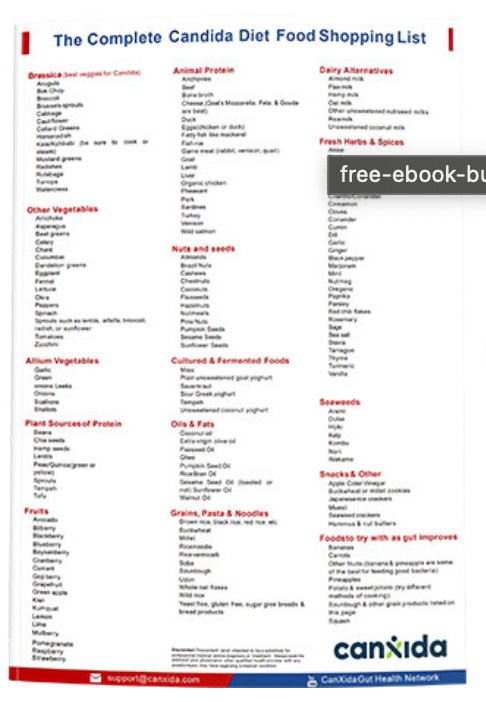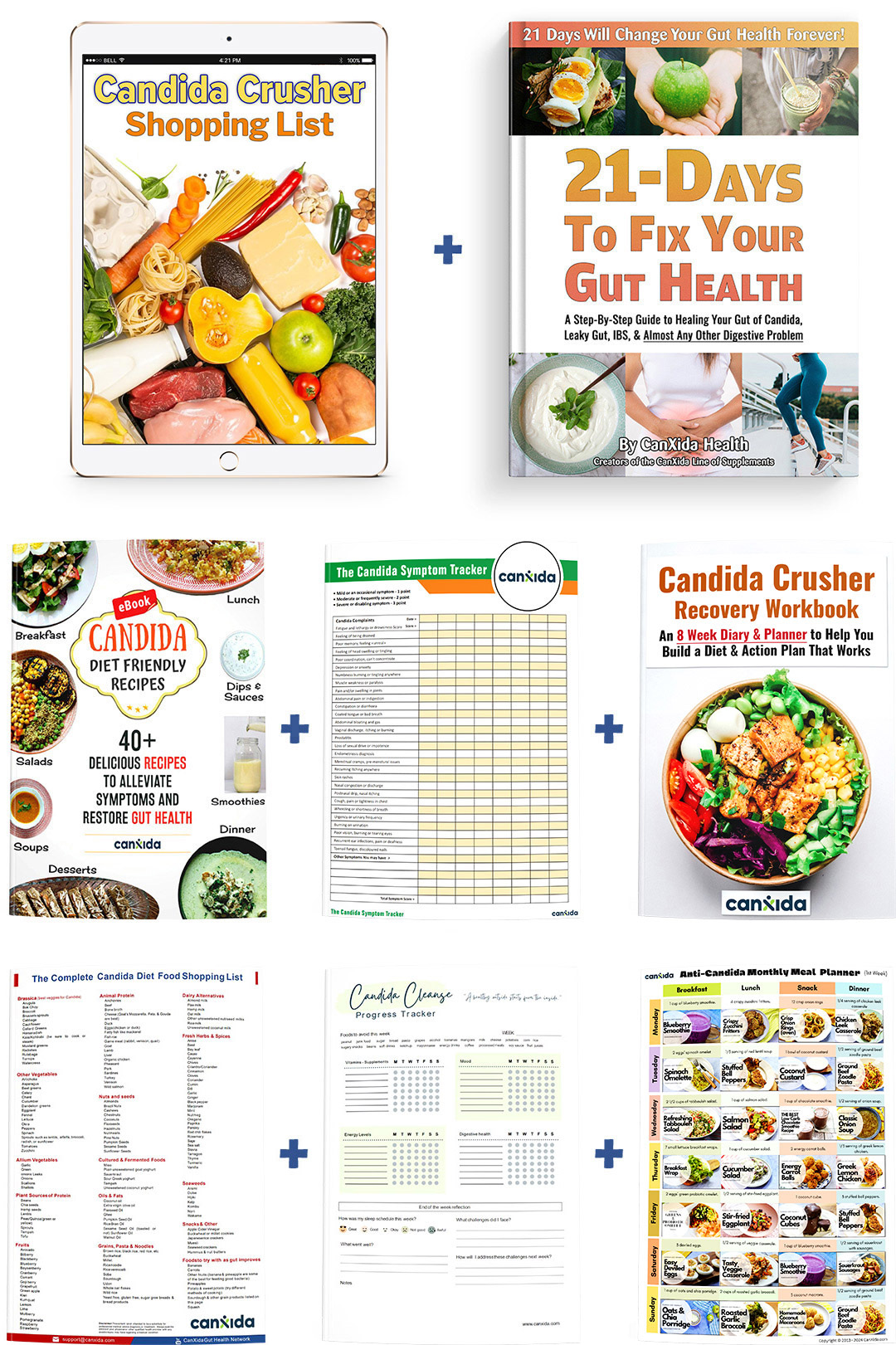
Candida Diet – Foods To Eat & Foods To Avoid (And Why That's Not Enough)

If you’re here, you’ve probably heard that changing your diet is the key to overcoming Candida. While it’s true that knowing which foods to eat and avoid is important, it’s not the whole story.
In our decades of experience, we’ve seen that simply eating ‘good’ Candida foods and avoiding the ‘bad’ ones often leads to only temporary relief—and the results don’t last.
Most people try to overcome Candida by focusing solely on foods to eat and foods to avoid. While this might provide some initial improvement, Candida overgrowth is a more complex issue.
Long-term success comes from understanding the key phases of recovery—phases that focus on not just what you eat but on restoring balance to your gut and supporting overall health. That’s why we recommend following our CanXida Protocol, which is based on our decades of clinical experience. It’s a 3-phase Candida diet that addresses not just what you eat, but how you eat, cleanse, and heal.
You can learn more about our 3-phase CanXida Protocol by clicking here.
Before continuing with this article, we strongly recommend watching the video below, which dives much deeper into the topic of what foods to eat on a Candida diet.
Foods To Eat
To make it easier, we’ve categorized these foods into clear, easy-to-follow groups:
- Vegetables (e.g., Brassica, Allium, and others)
- Brassica is a group of vegetables that are particularly powerful in dealing with digestive issues, such as Candida overgrowth. Vegetables like broccoli, Brussels sprouts, kale, and bok choy all belong to the Brassica family, and each has a unique role in promoting gut health.
- Allium vegetables contain foods like garlic, onions, and leeks. They are delicious in soups and stews and have strong anti-Candida properties.
- Plenty of vegetables besides Brassica and Allium have profoundly positive effects on our digestive system. We recommend that vegetables be provided as the basis of any anti-Candida diet. Particularly beneficial vegetables like spinach and okra.
- Fruits
- Some fruits are high in sugar, so they may not be the most suitable for tackling Candida, which thrives off sugar. However, that doesn’t mean you should steer clear altogether. Fruits are abundant in vitamins, minerals, and antioxidants, which can help your digestive and immune systems. Here are some fruits that punch above their weight when it comes to nutrition and digestive function kiwi and avocado.
- Nuts & Seeds
- Easily the most snackable foods on the Candida diet. Nuts and seeds are delicious and can benefit your digestive system enormously. Once again, these foods are high in fiber, which helps with overall digestive flow and comfort. Nuts and seeds are also packed with minerals, which help maintain a robust digestive system. One nut we highly recommend is pistachios.
- Cultured & Fermented Foods
- Some people may see the word fermented and start backing away with their hands raised. After all, yeast is used in fermented foods, right? While this is true of some foodstuffs, cultured and fermented foods offer various powerful options for an anti-Candida diet. These foods help populate your gut with good bacteria that help keep Candida levels at bay. We recommend Greek yogurt, and unsweetened coconut yogurt.
- Protein (Plant-Based and Animal)
- Plant proteins are a great way to get the protein you need while adhering to vegetarian/vegan diets. Lentils, in particular, are a fantastic source of plant-based protein and can be used as a base for many meals as an alternative to rice and potatoes. Other delicious foods in this category include tofu, tempeh, beans, and peas.
- Animal protein provide high nutrient and protein density, making it easier to feel full without consuming sugar. While all are nutritionally valuable, some offer specific benefits in dealing with Candida. For instance, eggs contain biotin, among many other nutrients. Biotin is a soluble B vitamin that is important for a variety of metabolic functions, and its deficiency leaves the body vulnerable to Candida infection. Other sources include chicken, beef, lamb, fish.
- Oils & Fats
- Oils and fats have zero sugar and provide similar satiating effects to consuming high-protein foods. Oils are incredibly versatile and can be used as a seasoning, as a base for sauces and garnishes, and as a substrate for frying. While many oils can be part of a healthy diet, some have specific activities against Candida like coconut oil and olive oil.
- Grains, Pasta & Noodles
- These foodstuffs provide the base for meals across virtually all cultures, and fortunately, they can be a vital part of an anti-Candida diet. The high diversity of foods in this category can make it difficult to make the right choices but for starters we recommend millet and buckwheat.
- Bread Products
- You’ll be happy to learn that you don’t need to give up bread to stay on the right track. Try sourdough bread. Sourdough has become a popular DIY project for bread enthusiasts and contains lactic acid bacteria with antifungal properties.
- Dairy Alternatives
- Some dairy products, particularly sugary products like ice cream or high-sugar yogurts, are to be avoided while on a Candida diet. With this in mind, try almond milk. Almond milk can be used with tea, coffee, cereal, and baking, giving you a diverse, more health-focused alternative. Almond milk isn’t for you? Try alternatives like oat, hemp, and flax milk.
- Fresh Herbs & Spices
- Herbs and spices have been used to preserve food since time immemorial. It’s no wonder, therefore, that they have potent antimicrobial properties and are a delicious complement to any dish. Potent antifungal spices that we recommend are anise and oregano.
- Snacks & Other Essentials
- Snacks are an essential part of any diet, helping to bridge the gaps between the major meals of the day. However, impulsive snacking can make it easy to slip back into bad habits. Here are some delicious snacks, buckwheat or millet cookies, Japanese rice crackers, seaweed crackers or muesli.
This is just a short preview to give you an idea. Our Candida shopping list contains the complete list, allowing you to explore a wide variety of foods. Because organizing over 150 foods into a single article isn’t the most practical approach—it would be overwhelming and hard to navigate.
To make your Candida diet journey easier, we’ve created a simple, printable Candida diet food shopping list. This shopping list is categorized for your convenience, making it easy to reference and use whether you’re grocery shopping or meal planning.
With this list, everything you need is organized and ready at hand, helping you stay on track and save time. You can print this list and keep it handy while grocery shopping or meal planning.
In addition to the shopping list, we’ve included a short section on foods to try as your gut improves and you start feeling better. This makes it easier to transition into a long-term, balanced diet without fear of setbacks.
And that’s not all—our shopping list is part of the CanXida Candida Recovery Kit, which includes a suite of essential tools to help you on your Candida recovery journey:
- Candida-Friendly Recipes - Meal ideas to keep you on track.
- CanXida Candida Symptoms Tracker - One of the most useful tools for monitoring your symptoms and progress.
- Sample Meal Plan - To take the guesswork out of what to eat each day.
- Additional Guides - To support every step of your recovery process.
You can download our Candida Foods to Eat Shopping List and the complete Candida Recovery Kit by clicking here. These tools have helped thousands of people regain their health and make the Candida diet easy to follow.

Foods To Avoid
What Should You Avoid?
You don’t need to be a rocket scientist to figure out what to avoid when dealing with Candida.
The foods to avoid are often the same ones you see others eating—especially those who frequently complain about poor health, bloating, gas, fatigue, or digestive issues. These are the people who often find themselves visiting the doctor, seeking relief through various medications.
You already know the foods you need to avoid—they’re the ones you know deep down aren’t helping your health.
We strongly recommend watching our video on foods to avoid below before continuing with this article. The video covers many details that are difficult to convey in writing and provides valuable insights to help you make better choices.
Some foods are highly recommended to avoid because they can significantly impact your health.
It’s not just about the quantity or frequency of these foods—it’s about the relationship you have with them. If you find yourself overly enjoying or relying on these foods, it’s time to break that connection and make a change.
We have relationships with food—just like we have relationships with people. And just like people, those relationships can be good or bad. Sometimes, changing or severing a bad relationship can feel like a breath of fresh air.
Think about it: what food do you really enjoy eating that you know isn’t good for you? Is it a chocolate bar? Peanut butter? Grabbing a slice of bread with peanut butter and jam? Or maybe heading to the fridge multiple times a day for a glass of milk? Perhaps it’s the beer or wine you look forward to at the end of the day.
Now, take a moment to reflect. What’s the one food that immediately comes to mind? The one you’re having regularly, even though you know deep down you shouldn’t? You might tell yourself, “A little bit here and there won’t hurt,” or “One or two drinks a week is fine.”
But here’s the truth: it’s not fine. At the very top of the NO list for Candida recovery is alcohol.
If you’re not prepared to stop alcohol—even just one drink a week—then this article won’t help you. Recovery from Candida requires commitment, and continuing habits like drinking will hold you back from getting well. It’s time to let go of that relationship with alcohol.
It’s not just about avoiding specific foods either. If we gave you a list of foods to avoid, you’d likely find at least one that you’d struggle to give up—and that’s where the real challenge lies.
Take sugary treats, for example: candies, chocolates, biscuits, or any type of confectionery packed with sugar. These need to go. And chewing gum? That’s another habit we strongly recommend cutting out.
Chewing gum is more than just a bad habit. Constantly chewing sends confusing signals to your stomach, making it think food is on the way. Plus, the saliva you swallow while chewing often contains artificial sweeteners, which can act as neurotoxins. Avoid it altogether.
The same goes for that candy bar you’re tempted to grab at the checkout when shopping. Many of these behaviors are just habits you’ve accumulated over time.
It’s time to make changes—not just in what you eat, but in the habits and relationships you have with food. These changes are necessary to move forward and achieve lasting health.
In the first few weeks of the Candida diet, especially if you have a severe case, it’s important to avoid certain foods.
Grains, for instance, can be problematic.
Consuming too much wheat, rye, or other grains may upset your digestion as your body adjusts to a stricter dietary approach. It’s best to limit or avoid these foods during this transition.
Root vegetables like pumpkin, squash, sweet potato, carrot, and sweet corn should also be avoided in the first two to three weeks. These foods are naturally higher in sugars and starches, which can feed Candida. Instead, focus on greens and leafy vegetables to support your gut health. Our 3-phase Candida diet protocol delves deeper into this topic, we highly recommend you read our 3 phase candida diet protocol.
During this transition, take care with how you approach your meals. Focus on chewing your food thoroughly, maintaining a consistent sleep schedule, and incorporating probiotics (without prebiotics) into your routine. Relaxation and stress management are equally important, as they play a significant role in improving your gut’s digestive function and overall health.
Digesting food is a demanding process for your body, so the goal is to improve gut function and bowel tone. Having regular, healthy bowel motions is key—aim for at least two per day for optimal gut health. Unfortunately, issues like constipation are widespread, with many patients reporting bowel movements only once a day or even every other day. Breaking this pattern and establishing regularity is essential for long-term recovery.
Stop eating takeaway food.
Do you often grab a quick meal like fried chicken, pizza, or greasy takeout dishes? While they may be convenient, they’re anything but convenient for your digestive system. These foods, along with processed items in tins, packets, or boxes, should be avoided as much as possible.
There are exceptions for some tinned foods, like sardines or salmon, but the majority of your diet should consist of fresh, raw, and unprocessed ingredients. The fresher and cleaner you eat, the better your digestion will function. This improves enzyme production, enhances gut health, and supports the growth of beneficial bacteria in your gut.
Your gut contains anywhere from 500 to 1,000 species of bacteria, which adapt based on your diet and stress levels. Improving your diet will gradually improve your gut flora. A healthier gut flora can crowd out Candida and other issues like SIBO, leading to a dramatic improvement in your overall health. Remember, all health starts in the gut.
Another important point: avoid cooking meals and storing them covered with cling film in the refrigerator, only to microwave them the next day. Bacteria, molds, and fungi can grow on that food overnight, making it less fresh and potentially harmful. If you’re storing food, freeze it right away, and when reheating, use an oven instead of a microwave.
Watch out for sauces like tomato sauce, chili sauce, or ketchup. How many half-used jars are sitting in your refrigerator right now? These are often mold, fungus, and bacteria traps. Use them sparingly, and if you’re transitioning to a healthier diet, it’s best to avoid sauces altogether.
For your next steps, we strongly recommend:
- Watching both videos on Foods to Eat and Foods to Avoid, which cover these topics in more depth.
- Reading our comprehensive 3-Phase Candida Diet Protocol for a structured approach to recovery.
- Grab your candida shopping list which contains full list of foods to eat, our candida symptoms tracker and more.
To your health,
CanXida Team
Click the Button Below to Grab Your 100% FREE Candida Beginner's Kit - includes candida shopping list

What's Included in the Candida Beginner's Kit:
- Candida Crusher Grocery Shopping Guide: 187 Foods To Eat (24 pages)
- Candida Diet Friendly Recipes: 40+ Delicious Recipes to Restore Gut Health (94 pages)
- 21-Days To Improve Your Gut Health: A Step-By-Step Guide to Healing Your Gut (67 pages)
- The Candida Symptoms Tracker: Your Ultimate Tool To Recovery (6 pages)
- Candida Detox Planner: A 8 Week Health and Fitness Journal (64 pages)
- Complete Candida Diet Food Shopping List (1 pg)
- Candida Cleanse Progress Tracker (1 pg)
- Sample Meal Plan (1 pg)
About CanXida Health:
About CanXida Health:

We launched CanXida Health in 2013 with one goal – to provide people like you with all the tools needed to manage Candida, Leaky Gut, IBS, SIBO & (almost) any other gut issue.
In addition to making premium grade supplements to target a wide range of gut disorders, we also run the CanXida YouTube channel where you'll find over 3,000 educational videos (along with several ebooks) on how to get your gut working normal again. Visit our website to learn more.
© All material is copyright protected 2013-2024 CanXida.com
Disclaimer: All material provided on the web site is provided for informational or educational purposes only. No content is intended to be a substitute for professional medical advice, diagnosis or treatment. Consult your physician regarding the applicability of any opinions or recommendations with respect to your symptoms or medical condition.
Contact Us | FAQ | Terms & Conditions | Disclaimer | Privacy Policy